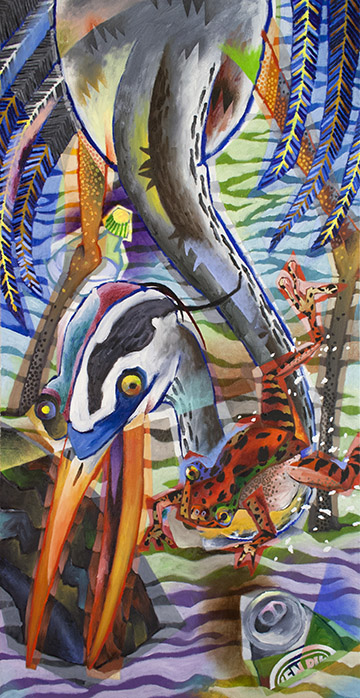
Here’s my process on an abstraction I recently finished for the upcoming show titled “AVIAN: Birds in a Changing World.” The competition will be open to artist across North America and sponsored by local non-profit organizations Sierra Art Trails (the group that puts together our annual artist’s open studio tour) and Yosemite Audubon, with proceeds going to support the two organizations.
I’ve never painted a bird before and had some difficulty in selecting a subject. We’ve got a seasonal pond on our property, up here in the Sierra Nevada foothills, and, on occasion, a great blue heron will drop in for an hour or so to sample from the many frogs that call the basin home. We’re pretty excited when this occurs, so I figured that would be a good subject to begin with.
While our watershed is pretty pristine, these guys travel great distances, stopping for a quick meal at myriad locals as they go. Even up here, near Yosemite, I’m amazed at what people will dump in remote locations (I’m talking old sofas and refrigerators). I imagined what the herons might be facing when they feed in more urban areas.
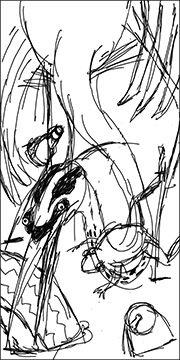
I started by collecting a lot of photos, from the Internet, of herons and frogs. Then created a quick thumbnail sketch on my computer. Given that everything on the heron is elongated, long legs, long neck, long beak, I thought utilizing a 1:2 ratio canvas might work well, so sketched using that aspect ratio. Usually, it takes two or three thumbnails, before I land on a composition or concept I like, but this time I felt I had something I could work with in my first sketch. I was a little concerned as to whether or not the frog’s placement over the bottom curve in the heron’s neck would be a problem, but I was confident I’d be able to work it out through color and value.
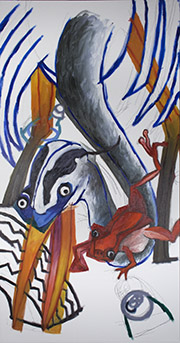
I had a blank 36″ x 18″ canvas already, put it up on the easel and had at it. Even with the time eaten by the thumbnail concept sketch, I got pretty far with the painting that first session (with a large part of the day taken up by communications and marketing, I clear at least four hours, at the end of each day, to paint).
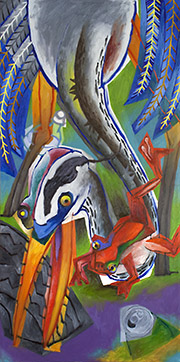
Three more sessions and I had most of the base color blocked in and could start actually painting. I began by dividing the heron’s neck into two surfaces, with a line down the center, adding a few stylized feather tufts in the process. I also added a pattern to the front of the neck, inspired by the coloring actually on the bird. I scrubbed in a bit of Indian Red at the neck base to delineate it from the body. Inspiration prompted me to add a bit of blue and green to the frog, so I slapped that in, before the thought evaporated. I decided to make the right side to the heron’s head a kind of negative of the left. Finally, I added quill spines to the feathers and tried out a possible paint pattern application. At the time, I felt the light yellow spines might need to be toned down, both in chroma and value, but decided to wait until the painting was more complete, before making that decision.
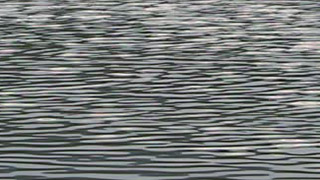
From the start, I’d planned some kind of pattern for the surface of the pond. Since I paint both foreground and background images with color of equal intensity, I need to rely on other graphic means to achieve separation and a hierarchy of importance. Patterns recede, so I knew using one here would be a good way to move the heron and frog to the forefront of interest. I didn’t want realism here, I wanted a graphic solution, but a solution inspired by reality. I went to the Internet again for reference.
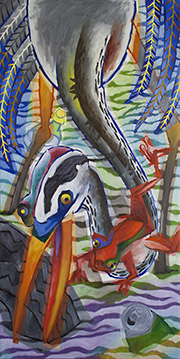
Testing my solution out as a layer overlay in Photoshop, I refined my pattern until I was confident it would work, before committing it to paint. I do this often if I’m considering something that will require a lot of scrapping out and repainting, if it doesn’t work. A huge time and frustration saver. Here’s the painting with the surface pattern added.
Jump ahead about 3 more sessions and I’ve made a lot of painting progress. I’ve separated the frog from the heron’s neck with a medium blue and cad yellow/orange and added a black pattern to his skin. Your mind is geared to interpret everything as 3 dimensional, so even when it’s confronted with a clearly 2 dimensional image, its tendency is to process it in 3D terms. For example, it interprets large elements as being closer to it than smaller ones and an element that overlaps the edge of another element as being in front of that element, etc. This is so we can safely navigate a 3 dimensional world.
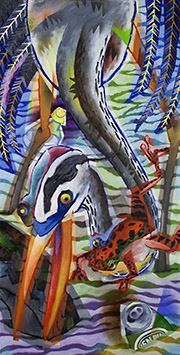
A lot of what I’m doing, in my abstracts, is trying to bring attention back to the 2 dimensional surface of my canvases and override any projected illusion of 3 dimensional depth…to flatten my paintings. With that in mind, I’ve continued outside contours, defined additional forms and added a feather tuft pattern to the heron’s body. I’ve applied the earlier established pattern to all the feathers and brought attention to their 2 dimensional surface contours, with a swatch of pink paint. I added a label to the beer can, detailed it’s top and continued some of its contours across the pond surface. I moved the top of the plastic bottle forward by added a soft deep violet shape behind it. I defined a new plane along the top of the heron’s beak/mouth. I’ve also begun to detail the tire. At this point, I decided the light yellow feather spines were working fine and didn’t need to be changed.
Another 6 sessions and I arrived at the finish shown at the top of this post. Through those sessions I added patterns to the heron’s legs and frog’s belly, used color and value to define the planes that make up the frog, added nostrils to the heron and darkened the inside of his mouth. I also, added detail to the geometric color shape continued outside of the heron’s beak, further separated the two planes of his neck with a pale blue and added more surface form detail, with the addition of blue, to the right wing of the heron. Additionally, I added a surface contour running across the tire, heron’s beak and neck and pond surface. A few droplets of foam flying from the frog and a bit of minor adjustment here and there and I determined it finished. Wish me luck!
